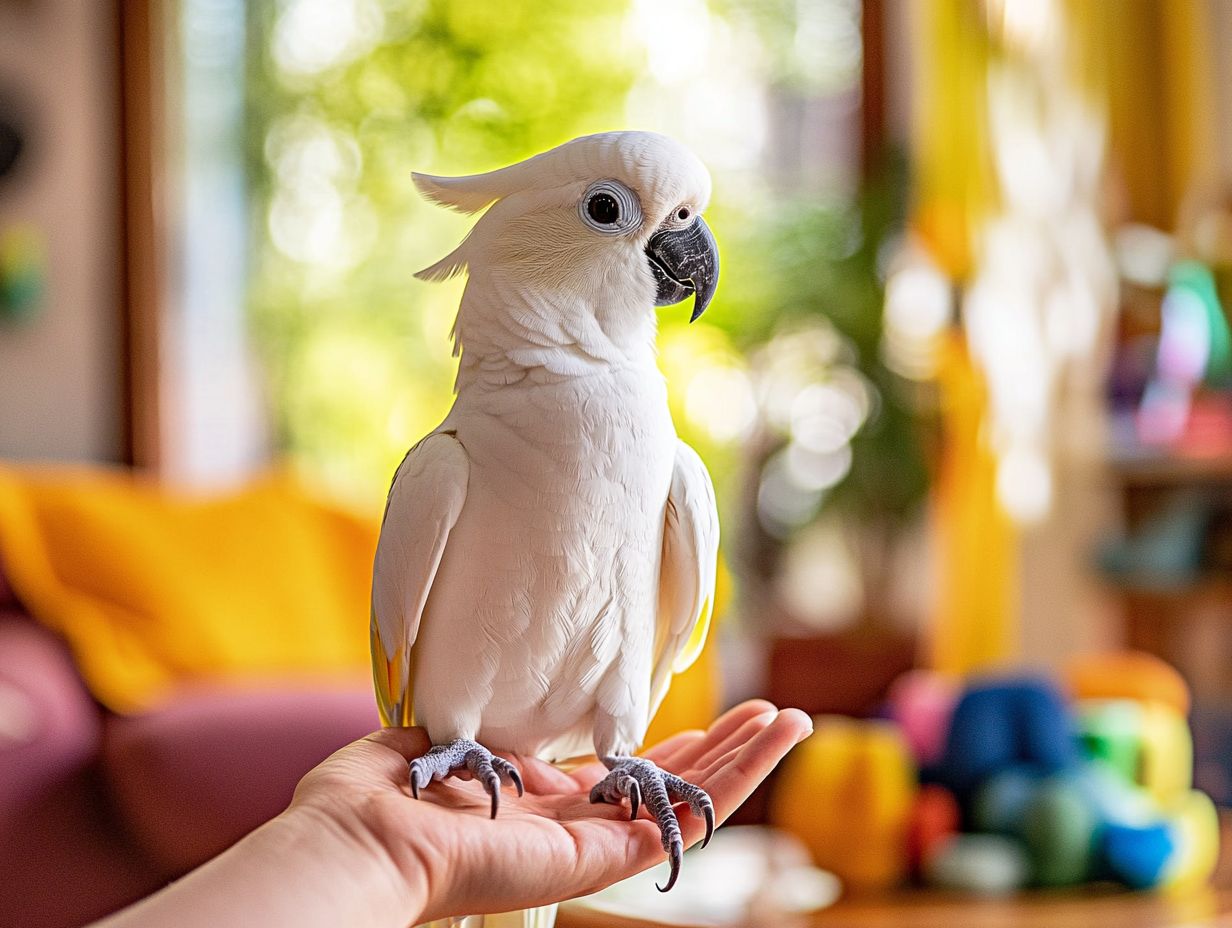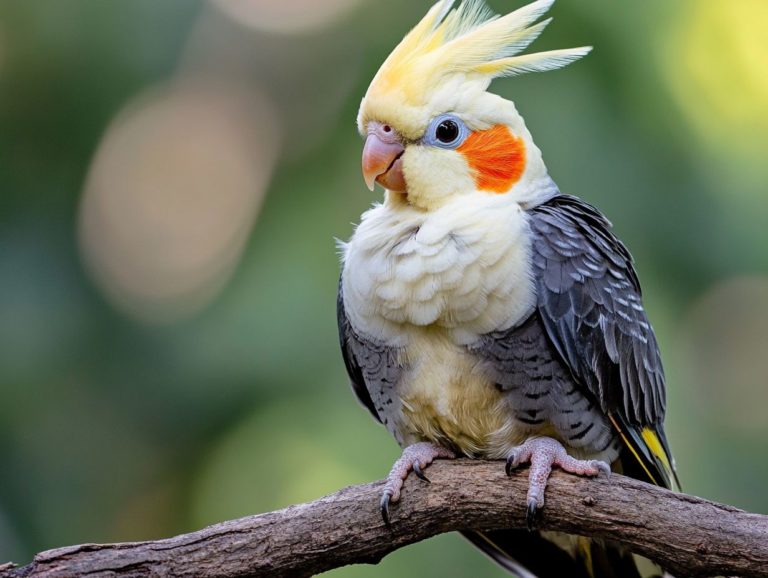5 Best Training Techniques for Cockatoos
Training your cockatoo can be an incredibly rewarding experience, elevating both your pet’s well-being and the bond you share.
Here are five effective training techniques spanning from positive reinforcement to flight training that will keep your feathered friend engaged and content.
You ll also explore the benefits of training, identify common pitfalls to steer clear of, and discover some delightful tricks to teach.
Whether you re a first-time cockatoo owner or seeking to refine your skills, this guide has valuable insights for everyone.
Contents
- Key Takeaways:
- 1. Positive Reinforcement Training
- 2. Clicker Training
- 3. Target Training
- 4. Socialization Training
- 5. Flight Training
- How to Choose the Right Training Technique for Your Cockatoo?
- Frequently Asked Questions
- What are the 5 best training techniques for cockatoos?
- How does positive reinforcement help in cockatoo training?
- What is target training and how can it benefit cockatoos?
- Why is clicker training effective for cockatoos?
- How can desensitization be used in cockatoo training?
- Why is socialization important for cockatoos and how can it be incorporated into training?
Key Takeaways:

1. Positive Reinforcement Training
Positive Reinforcement Training stands out as a highly effective method in avian behavior management, especially for larger birds like the Congo African Grey, Moluccan Cockatoo, and Galah Bondi. This approach not only fosters a strong bond between you and your bird but also promotes desirable behaviors, as outlined in the 5 steps to successfully train your bird.
By using event markers such as clickers and rewarding your feathered friend with treats like sunflower seeds or peanuts during training, you create an environment ripe for learning. Patience and consistency in each short session will be your allies, making it easier to teach behaviors like stepping up or target training effectively.
In this method, the focus is on encouraging specific actions through immediate rewards, reinforcing the idea that good behavior leads to positive outcomes. For example, when your bird successfully returns to its perch on command, the sound of a clicker followed by a treat can significantly enhance the learning experience.
If you re working with a bird that shows fearful behaviors, positive reinforcement can help create a safer environment. Over time, this approach allows them to associate previously negative stimuli with positive experiences, effectively reducing anxiety and building their confidence.
2. Clicker Training
Clicker training is an artful method of positive reinforcement that employs a distinctive sound to indicate to your birds, such as the Congo African Grey and Moluccan Cockatoo, that they’ve executed a desired behavior correctly. This is usually followed by a delectable reward, like a sunflower seed or peanut, making it an effective technique in your overall training journey.
This approach serves as a precise event marker, establishing a clear connection between the click sound and the subsequent reward. At first, you ll click immediately after your bird performs the desired behavior, followed by presenting a treat. Over time, your feathered friend will learn to associate that click with commendable actions, transforming it into a powerful tool for shaping and reinforcing a variety of behaviors.
What s truly captivating about clicker training is its versatility. It allows for training sessions that are not only concise but also focused, enabling you to make swift adjustments while keeping your bird engaged. With consistent practice, you will cultivate better communication, ultimately deepening the bond you share with your avian companion.
3. Target Training
Target training is an essential technique in your avian training toolkit, especially when working with larger birds like the Congo African Grey and Moluccan Cockatoo. You’ll use a target stick to guide your bird to desired locations or behaviors, keeping your training sessions short to maintain focus and boost learning outcomes.
This method shines because it establishes a clear and consistent signal that your bird can easily grasp. By pairing clicker training with the target stick, you can effectively reinforce the behaviors you want to encourage. For instance, getting your bird to step onto a perch or come to you becomes a breeze when you’re using the clicker for positive reinforcement every time the target stick is touched.
You can even teach fun tricks like spinning, waving, or simple fetch exercises. This engaging approach not only promotes skill acquisition but also fosters a delightful bonding experience between you and your bird.
4. Socialization Training

Socialization training is vital for birds like the Galah and Moluccan Cockatoo. It helps them adapt to different environments and people, reducing their fear responses.
Start a structured program that gradually introduces your bird to various sounds, sights, and other pets. Letting your bird observe family gatherings from a safe distance helps them get used to new experiences.
Use rewarding techniques like treats or praise to make these moments enjoyable. Creating a dedicated play area with fun toys encourages exploration, while a calm atmosphere helps them feel safe.
5. Flight Training
Flight training is essential for larger birds like the Congo African Grey and Moluccan Cockatoo. It promotes natural behaviors while ensuring their safety, but it can also present common training challenges with birds.
Begin with short sessions that let them experience the joy of flying in a secure space. Gradually increase distances and heights to build their confidence in flying abilities.
Use positive reinforcement, like treats and praise, to encourage exploration. If they show fear of heights or new places, be patient and reward their small achievements.
How to Choose the Right Training Technique for Your Cockatoo?
Choosing the right training technique starts with understanding your cockatoo’s unique traits. Factors like age, temperament, and past experiences will help you explore creative ways to train your bird and guide your method selection.
By recognizing their personality, you can tailor your approach, making it enjoyable for both of you. Some cockatoos respond well to reward systems, while others thrive on routine and consistency.
Pay attention to your bird s reactions during training. These responses reveal their preferences, helping to enhance your future strategies.
What Are the Benefits of Training Your Cockatoo?
Training your cockatoo brings many benefits. It enhances your communication and improves behavior management.
Regular training sessions provide crucial cognitive stimulation, boosting their confidence as they learn new skills. This interaction also strengthens your emotional bond.
Socialization through training encourages positive interactions with humans and other pets. It helps curb behavioral issues like aggression or excessive screeching.
By establishing a routine, you promote your cockatoo s well-being, creating a happier, balanced environment for everyone.
What Are the Common Mistakes in Cockatoo Training?

Common mistakes in cockatoo training often arise from impatience, inconsistent reinforcement, and neglecting the importance of gradual exposure throughout the process. To enhance your training strategy, consider incorporating fun activities for your cockatoo, as these can help build trust and improve your bird’s ability to learn.
Such errors disrupt the training flow and can lead to anxiety and confusion in your cockatoo. You might overwhelm your bird with commands or rewards, failing to give it enough time to absorb the information. This rushed approach can create a negative environment that stifles learning.
Embrace patience for successful training! Provide ample time for your cockatoo to process cues while maintaining consistency in your commands and rewards. To enhance your training approach, consider these 5 tips for training older birds. This will set the stage for a trusting relationship, fostering a more engaging and productive training experience.
What Are Some Fun Tricks You Can Teach Your Cockatoo?
Teaching your cockatoo fun tricks provides important play and exercise while deepening your bond with your feathered friend. Popular behaviors to teach include “step up,” “wave,” and “play dead.” These can be effectively achieved using a small device that makes a sound to mark good behavior.
These fun activities encourage interaction and serve as a fantastic outlet for your bird s energy. To train the “step up” command, hold your hand in front of your cockatoo and gently nudge its belly to encourage it to step onto your finger. Using treats consistently will reinforce this behavior.
For the “wave” trick, introduce a visual cue, like a small flag or your hand, and reward your cockatoo every time it lifts its foot. Teaching your bird to “play dead” involves gently laying it on its back and offering praise and a treat when it remains still.
Maintaining a positive atmosphere filled with rewards is essential to keep your cockatoo enthusiastic and engaged. Start teaching your cockatoo a fun trick today and watch your bond grow!
How Can Training Improve the Bond between You and Your Cockatoo?
Effective training is essential for strengthening the bond between you and your cockatoo. Engaging in consistent activities, including 5 simple tricks to start training your bird, fosters mutual trust and understanding, leading to a more fulfilling relationship and a well-adjusted pet.
Using positive reinforcement techniques allows both you and your bird to reap emotional rewards, creating an environment where communication thrives. This method encourages desirable behaviors, and for those looking for more comprehensive advice, check out the 5 key strategies for training multiple birds, while instilling a sense of security and happiness in your cockatoo.
As you practice patience during training sessions, gradual progress builds resilience and confidence in your pet. You will gain a deeper appreciation for their unique personality. These interactions cultivate a richer emotional connection, turning each session into a treasured moment of shared joy and understanding.
What Are Some Important Considerations for Training a Cockatoo?
When you embark on training a cockatoo, several key considerations come into play. Understanding the bird’s personality, previous experiences, and the necessity for a gradual approach that respects its comfort level are central to a successful training process. Incorporating the right tools, such as the top 5 toys for training your bird, can also enhance the experience and effectiveness of your sessions.
Age is a crucial factor; younger birds may adapt more quickly but require consistent routines to establish boundaries effectively. Gauging the cockatoo s temperament allows you to tailor your training methods, ensuring they resonate with its unique quirks.
Additionally, specific needs such as the bird’s diet and socialization experiences play a significant role in overall training success. Creating a supportive environment free from distractions encourages focus and facilitates learning.
By incorporating positive reinforcement techniques, like treats and praise, you can make the training process enjoyable, fostering a trusting relationship between you and your feathered companion.
Frequently Asked Questions

What are the 5 best training techniques for cockatoos?
- Positive reinforcement
- Target training
- Clicker training
- Desensitization
- Socialization
How does positive reinforcement help in cockatoo training?
Positive reinforcement rewards your cockatoo with treats or praise for good actions.
This encourages them to repeat those actions and makes training more fun.
What is target training and how can it benefit cockatoos?
Target training teaches your cockatoo to touch a target, like a stick or a spot, with their beak or body.
This technique helps teach obedience and serves as a foundation for other tricks.
Why is clicker training effective for cockatoos?
Clicker training uses a small device that makes a distinct sound to mark good behavior.
This sound helps you communicate clearly with your cockatoo and can speed up training.
How can desensitization be used in cockatoo training?
Desensitization gradually exposes your cockatoo to things that might cause fear or stress.
This positive approach helps reduce anxiety, making training easier.
Socialization is exciting! It helps your cockatoo meet new faces, animals, and places safely.
This builds their confidence and makes training a breeze!
Start training your cockatoo today for better results and a happier pet!




